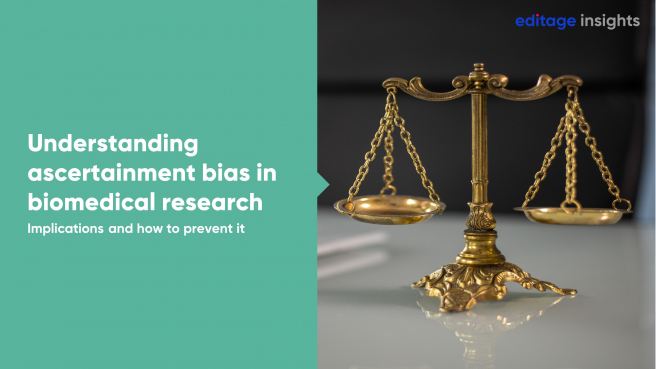Understanding ascertainment bias in biomedical research: Implications and how to prevent it

Biomedical research is susceptible to various biases that can compromise the validity and generalizability of research findings. One such bias that often goes unnoticed but can have significant implications is ascertainment bias. In this blogpost, we will delve into what ascertainment bias is, its implications in biomedical research, and strategies to prevent it, particularly for experienced biomedical researchers.
What is ascertainment bias?
Ascertainment bias, also known as detection or selection bias, refers to the systematic error that arises when the probability of detecting a particular outcome or condition is influenced by factors other than the exposure or intervention of interest. For example, if you wanted to assess the mortality rate of neonatal jaundice but drew your sample from NICU populations, your results might be biased because you have already restricted your study to critically ill neonates. In other words, ascertainment bias occurs when the study design or methodology increases the likelihood of a particular result. Let's look at the examples below to understand how ascertainment bias works.
Examples of ascertainment bias
One common scenario where ascertainment bias can occur in biomedical research is in the selection of study participants. If the criteria for selecting participants are not well-defined or are influenced by the researcher's beliefs, it can lead to a biased sample that may not accurately represent the target population. For example, if a study on the efficacy of a new drug for a certain condition only enrolls patients from a particular age group or with mild symptoms, the results may not be generalizable to the broader population, and the true effectiveness of the drug may be overestimated.
In another example, a study on the association between obesity and asthma may be susceptible to ascertainment bias if the study population is recruited from a hospital or clinic that specializes in bariatric surgery. The study may inadvertently over-represent individuals with Class 2 or 3 BMI. As a result, the observed association between may be exaggerated due to the increased likelihood of breathlessness in the study population compared to the general population.
Implications of ascertainment bias
The implications of ascertainment bias in biomedical research can be far-reaching. Biased results can lead to incorrect conclusions, misinform clinical practice, and waste resources. Biased findings may lead to the approval of ineffective interventions or the rejection of potentially beneficial ones, leading to suboptimal patient care. Biased research can also erode public trust in the scientific community and hinder the progress of scientific knowledge.
Take the above example of the study on obesity and asthma: the biased results may cause other researchers to design community-based asthma management interventions that include a weight loss component. Considerable time and money would be spent designing and conducting trials on these interventions, while subjects undergoing these interventions might even fail to adhere to them because of restrictions in diet, exercise requirements, etc. Thus, these interventions may be deemed to be overall ineffective because of an unnecessary weight loss component.
Strategies to prevent ascertainment bias
To prevent ascertainment bias in biomedical research, it is important for experienced researchers to be vigilant and apply rigorous study design and conduct principles. Here are some strategies that can be employed:
Clearly define study objectives and hypotheses: Before initiating a study, it is crucial to establish well-defined research objectives and hypotheses. This will help guide the study design, participant selection, and data collection, minimizing the risk of biased outcomes. For example, if you plan to examine the relationship between nutrition status and literacy skills in preschoolers, you will need to determine whether you will use a longitudinal or cross-sectional design, whether to exclude participants with ADHD or autism, etc.
Use standardized criteria for participant selection: Clearly define the inclusion and exclusion criteria for study participants and apply them consistently to all eligible individuals. Avoid arbitrary or subjective criteria that may introduce bias into the study sample. For example, using subjective criteria like "severe symptoms" to determine eligibility for inclusion or exclusion from a study can introduce bias, as severity may be assessed differently by different researchers. Also, consider the use of randomization and blinding techniques to minimize bias.
Minimize measurement bias: Use standardized and validated measurement tools to collect data on outcomes and exposures of interest. Train study personnel to collect data in a consistent and unbiased manner. Use objective measures, such as biomarkers or imaging, whenever possible to minimize measurement bias. For example, in evaluating the outcomes of a community-based walking intervention, you could choose to assess serum insulin and cholesterol levels in addition to a subjective questionnaire measuring quality of life.
Be transparent in reporting: Describe the study methods in detail in your research articles, including study design, participant selection, data collection, and data analysis. This will allow other researchers to assess the risk of bias and the generalizability of the findings.
Conduct sensitivity analyses: Perform sensitivity analyses to assess the robustness of study findings to potential sources of bias. This may involve re-analyzing the data using different assumptions or criteria to evaluate the impact of ascertainment bias on the results. For example, if you have excluded participants with specific comorbidities because you consider them to be confounders, you can reanalyze the data when those participants are included, to assess the robustness of your findings.
Collaborate with multidisciplinary teams: Collaborate with experts from various disciplines, such as epidemiology, biostatistics, and clinical medicine, to ensure rigorous study design and interpretation of findings. This can provide a valuable external perspective and help identify potential sources of bias. For example, an epidemiologist can advise you about a population-based sampling approach or how to efficiently extract data from public health records; a biostatistician can help you frame clear definitions of your exposure and outcome variables to ensure that data is consistent.
Stay updated with best practices: Stay informed about the latest guidelines and best practices in study design or data analysis, and incorporate them into your research. For instance, an observational study should ideally adhere to the STROBE guidelines, but recent research suggests that a notable proportion of observational studies fall short of these guidelines.i,ii
Do you want expert guidance on how to avoid various biases in your research? Consult with a biostatistician under Editage’s Statistical Analysis & Review Services.
Comments
You're looking to give wings to your academic career and publication journey. We like that!
Why don't we give you complete access! Create a free account and get unlimited access to all resources & a vibrant researcher community.

Subscribe to Conducting Research










